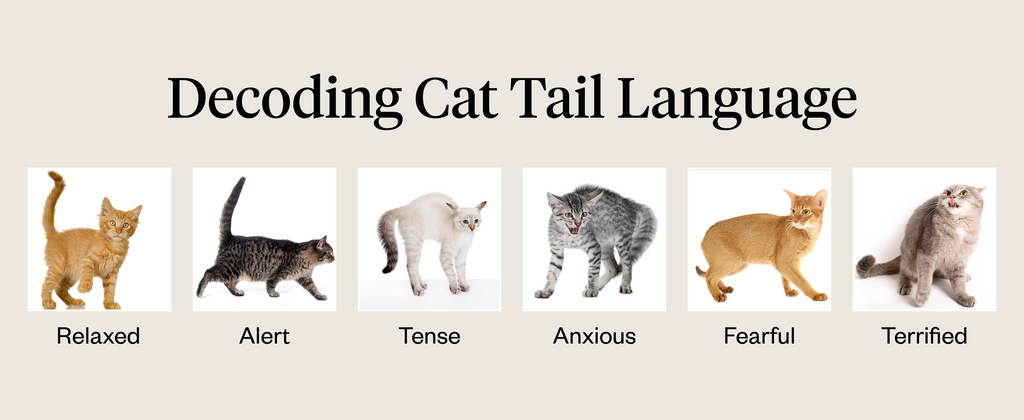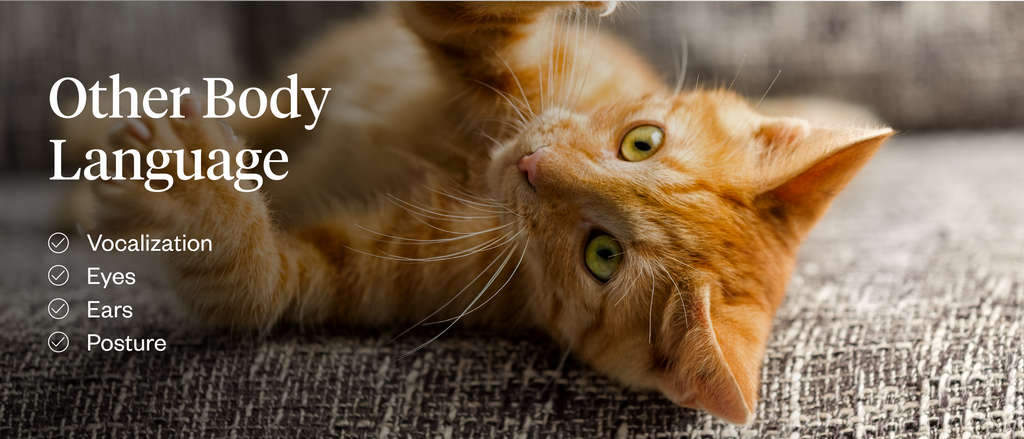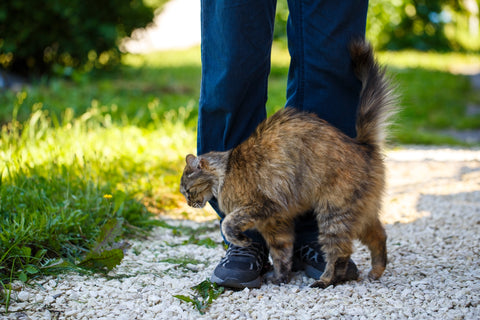9 Min Read
How to Read Your Cat’s Tail Language
Key takeaway

Why pet owners are switching to online vet care with Dutch
-
Prescriptions delivered free to you
-
Fast access to Licensed Vets over video
-
Unlimited video visits and follow-ups
Learning your cat's tail language can help you decipher their moods and intentions. Cats use their tails as a form of communication, conveying a range of emotions and messages through various tail positions and movements.
A cat's tail position and movement can give clues about their state of mind. Understanding cat body language and these subtle cues in your cat's tail language can help you interpret their emotions more accurately and respond accordingly to ensure their well-being and comfort.
Keep reading or learn more about how to read your cat’s tail language.

Decoding Cat Tail Language
Cats communicate with each other and humans in many ways, including vocalizations, body language, and scent marking. Cat sounds like meowing, purring, hissing, and trilling are how your cat expresses itself. Each vocalization conveys different messages, such as affection, fear, aggression, or distress.4
Scent marking is another important means of communication for cats. They have scent glands on their face, paws, and tail, which they use to communicate and mark their territory.4 Rubbing against objects, scratching, and urine marking are common ways cats deposit their scent.
Another way to interpret your cat is by understanding their body language, with various postures and movements conveying different emotions and intentions. Ear position, facial expressions, and tail position can provide subtle yet valuable clues about what your cat is thinking and feeling.

So, how can you interpret body and tail language? Let's take a look at a few examples of cat tail body language and what they mean:
Relaxed
When a cat is relaxed, its tail is typically held in a neutral position or slightly elevated with a gentle curve at the top.2 The tail may sway gently from side to side or have a relaxed, fluid motion.
Sometimes, a relaxed cat may even wrap its tail around its body or drape it loosely over its back.2 This tail posture indicates that the cat feels comfortable and secure in its environment, showing trust and contentment.
Alert
An alert cat will hold its tail upright, with the tail straight and rigid or slightly curved at the top. The tail may also twitch or flick subtly from side to side as the cat focuses on something of interest.2
This posture suggests that the cat is attentive and aware of its surroundings, possibly preparing to investigate or respond to a stimulus. The tail's raised position also makes the cat appear larger, which can be a defensive posture in some situations.
Tense
When a cat feels tense or anxious, its tail may be held low to the ground or tucked tightly between its legs and close to the body. The tail may appear stiff and straight, with little to no movement or twitch when standing, indicating the cat is feeling threatened or fearful.2
In some cases, the tail (or tip of the tail) may even lash back and forth rapidly, a sign of heightened agitation or aggression. This tail posture signals that the cat is on edge and may be preparing to defend itself or flee from perceived danger.
Anxious
When a cat feels anxious, its tail may be held low or tucked between its legs. The tail may twitch nervously or move from side to side slowly and deliberately.2
Other signs of anxiety in cats may include dilated pupils, flattened ears, and a crouched or hunched body posture.2 An anxious cat may also groom excessively or seek hiding spots to retreat from perceived threats.
Fearful
A fearful cat may exhibit similar tail postures to an anxious cat, with the tail held low or tucked close to the body.2 However, besides these signs, a fearful cat may puff up its fur to appear larger and more intimidating.
The tail may wag, quiver, or shake uncontrollably, and the cat may freeze in place or attempt to flee from the perceived threat. Wide eyes, flattened ears, and a tense body posture are common indicators of fear in cats.2
Terrified
When a cat is terrified, the tail is often held low or tucked between the hind legs, indicating extreme fear and submission. It may also appear bristled or larger.3 The cat may try to make itself appear smaller by crouching or flattening its body against the ground.2
Trembling, rapid breathing, and vocalizations such as yowling or hissing may accompany a cat's terrified state.2 In some cases, a terrified cat may become aggressive as a defensive response to a perceived threat.3

Other Body Language Indicators
As mentioned, cat tail body language isn't the only indication of their feelings. In addition to tail language, cats use other forms of body language to communicate. Understanding these cues can provide insights into their state of mind.
- Vocalization: Cats use a range of vocalizations to express themselves, including meowing, purring, hissing, growling, and yowling. Each sound may convey different emotions or messages, such as contentment, aggression, fear, or distress. For instance, a relaxed cat may be silent or purr, while a fearful or anxious cat may hiss, growl, and yowl.2
- Eyes: Your cat's eyes can reveal a lot about their mood. Dilated pupils may indicate excitement, fear, or arousal, while constricted pupils may suggest discomfort.2
- Ears: A cat's ears are highly expressive and can be positioned in various ways to convey emotions. Forward-facing ears indicate curiosity or alertness, while flattened ears suggest fear, aggression, or discomfort. Ears turned to the side or slightly back may indicate mild stress, relaxation, or contentment.2
- Posture: A cat's body posture can reveal a lot about their mood and intentions. A relaxed cat typically has a loose, fluid body posture, with its weight evenly distributed. Conversely, a tense or defensive cat may hold its body close to the ground, with its muscles tense and ready for action.2
Looking for body language indicators for dogs? Learn how to read dog body language.

Communicating With Your Cat
Communicating effectively with your cat involves understanding their body language and behaviors and fostering positive interactions that promote trust and mutual respect. Here are some tips to help you better communicate with your feline friend:
- Learn to read body language: Pay attention to your cat's body language, including tail position, ear posture, vocalizations, and overall demeanor. Understanding these cues can help you understand your cat's mood and emotions, allowing you to respond to their needs.4
- Approach gently and respectfully: When interacting with your cat, approach them gently and don't make sudden movements that may startle them. Allow your cat to initiate contact and respect their boundaries if they show discomfort or aggression.4
- Provide positive reinforcement: Utilize positive reinforcement techniques, such as treats, praise, and affection, to reward desirable behaviors in your cat. This helps reinforce good habits and strengthens the bond between you and your pet.
- Create a safe and enriching environment: Ensure your cat has a safe and enriching environment that meets their physical and mental needs. Provide plenty of opportunities for play, exploration, and relaxation, as well as access to food, water, litter boxes, and scratching posts.
- Be patient and understanding: Cats have their own unique personalities and may require time to adjust to new situations or changes in their environments. Be patient and understanding with your cat, and give them the space and time they need to feel comfortable and secure.
- Communicate nonverbally: Use nonverbal cues, such as eye contact, slow blinking, and gentle petting, to communicate with your cat in a way they understand. Avoid harsh punishment or yelling, as this can impact the bond between you and your pet, leading to fear and distrust.4
- Respect your cat's independence: While cats can be affectionate and social, they also value their independence and may sometimes prefer solitary activities. Respect your cat's need for space and alone time, and allow them to retreat to a quiet area.
Final Notes
Understanding your cat's tail body language can help you decipher their emotions and intentions. By observing the position and movements of their tail, you can respond to their needs to ensure their well-being. Cats also communicate through vocalizations, scent marketing, and other forms of body language, such as ear position and posture. Learning to interpret these cues can help you better understand your cat and strengthen your bond with them.
Effective communication with your cat fosters a harmonious relationship with them and ensures a happy and fulfilling life together. Knowing when your cat is anxious or fearful can help you determine the root cause and prevent behavior issues later.
Let Dutch telemedicine for pets help you and your cat communicate better. We offer convenient access to licensed veterinarians and medications through our online pet pharmacy to ensure your cat's well-being. Try Dutch today to learn more about your cat.
Share
References
-
"How Do Cats Communicate with Each Other?" The Library of Congress, www.loc.gov/everyday-mysteries/zoology/item/how-do-cats-communicate-with-each-other/.
-
"Reading Your Cat's 'Body Language.'" OSU, indoorpet.osu.edu/sites/indoorpet/files/assets/documents/hospital/indoorcat/Reading%20Cat%20Body%20Language.pdf.
-
"Cats." University of Maryland, UMBC, userpages.umbc.edu/~maggief1/art388/Project%20B/page4.html.
